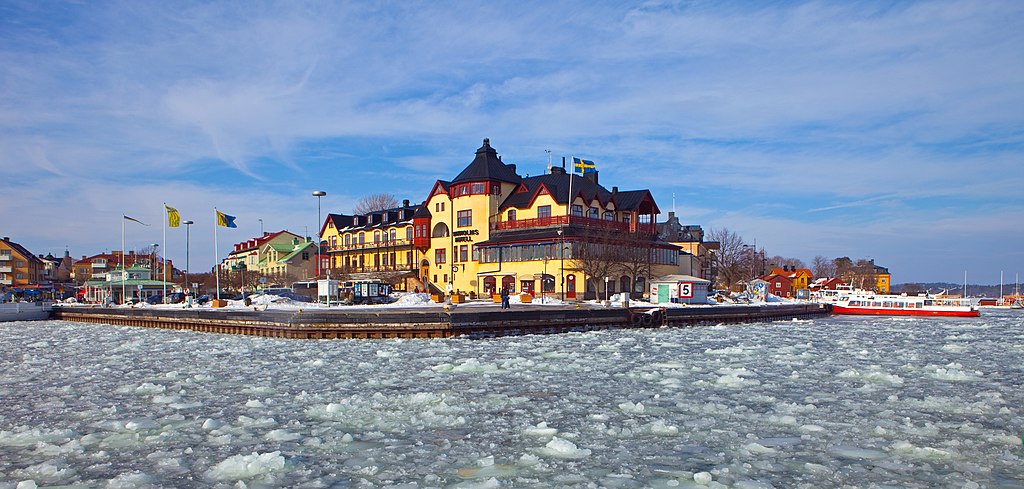
The novel Pippi Longstocking was written by the Swedish author Astrid Lindgren. The Thammasat University Library owns a copy, shelved in the Fiction Stacks of the Pridi Banomyong Library, Tha Prachan campus. Astrid Lindgren is also the author of Noy Lives in Thailand which is shelved in the General Stacks of the Pridi Banomyong Library.
Noy Lives in Thailand is part of a series of books published in the mid-1960s about children of the world. In Noy Lives in Thailand, Noy is the daughter of a farmer from provincial Thailand. Her life is filled with countryside experiences. She has a brother named Tavi who explains why he enjoys going swimming all the time: I like to bathe too, even though I’m not a buffalo. Noy’s father allows her to accompany him on a trip to Bangkok to sell the fruits and vegetables grown on his farm. In Bangkok, Noy wanders away from her father and looks with interest at the city, before her father finds her again. Noy Lives in Thailand also features photographs of Thailand by the Russian-born Swedish photographer Anna Riwkin-Brick. As part of the series, Riwkin-Brick travelled to different countries around the world to take photos, while Lindgren accompanied her on many trips, or followed her later to see the countries for herself. So it is likely that Lindgren visited Thailand in 1965 or 1966 to prepare the text for Noy Lives in Thailand.
The TU Library also owns other books by and about Astrid Lindgren. Pippi Longstocking remains Lindgren’s most popular book. It is about a very strong nine-year-old girl with red hair. He can lift a horse in the air using only one hand. Her father is a pirate. She also has a pet monkey. She calls herself the strongest girl in the world, but uses her strength to promote nonviolence and to persuade children to stop bullying others.As her name indicates, she wore long stockings. Pippi Longstocking has been translated into many different languages, including Thai ( as ปิ๊ปปี้ ถุงเท้ายาว), Chinese, Filipino, Hindi, Indonesian, Japanese, Korean, Sinhalese, Vietnamese, and several others.

Cultural influence of Pippi Longstocking
Last year in an online interview, His Excellency Staffan Herrström, the Swedish Ambassador to Thailand, and his wife were asked who would be their preferred guest for dinner. Mrs. Herrström, who is involved with the World Childhood Foundation, an organization founded by Queen Silvia of Sweden in 1999 to support children at risk around the world, answered that she would prefer to invite Astrid Lindgren. In 2016, the Swedish Film Festival, presented by the Embassy of Sweden in Bangkok in collaboration with SF World Cinema, included the documentary Astrid about Astrid Lindgren. The same year, HE Ambassador Herrström wrote an opinion article in The Bangkok Post citing Lindgren in her views opposing violence against children. A speech given by Astrid Lindgren when she accepted the German Booksellers’ Peace Prize in Frankfurt in 1978 was especially influential. As a result of her advocacy, in 1979, a law was passed in Sweden prohibiting violence against children, the first such law in the world.
In her speech, she explained:
I want to talk about the children. My worries about them, and my hopes for them. The children of today will eventually take over the running of our world, if there is anything left of it. They are the ones who will make decisions concerning war and peace and the kind of society they want to have – if they want a society in which violence continues to grow, or if they prefer one in which people live in peace and brotherhood. Is there any hope at all that they will be able to create a more peaceful world than the one we have lumbered ourselves with? And why have we failed so badly, despite all the goodwill that exists?... There are so many really “spoiled children” in this world of ours today, so many dictators, tyrants, oppressors, torturers – what sort of a childhood did they have? That is something that really ought to be researched. I believe that behind most of them is a tyrannical father or some other figure responsible for their upbringing, wielding a rod or a whip.
Children’s literature has no shortage of depictions of rancorous childhoods featuring domestic tyrants who have beaten their children into a state of obedience and submission, and more or less ruined their lives. But happily they were not the only kind. Thankfully there have always been parents who have brought up their children in an atmosphere of love without violence. But it is probably true to say that it is only in the twentieth century that parents in general have begun to regard their children as their equals, and given them the right to let their personalities develop freely in a family characterized by democracy, without oppression and without violence.

The TU Library owns a number of studies about how to prevent family violence. Lindgren opposed those who believed that corporal punishment was necessary to teach children how to behave:
Many parents will no doubt be worried by these new trends, and may start to wonder if they have done wrong, if an anti-authoritarian upbringing is reprehensible. But it is only reprehensible if it is misunderstood. An anti-authoritarian upbringing does not mean that children should be left to drift along and do whatever they please. It does not mean that they should grow up without a set of norms – nor do they want to. Both children and adults need a set of norms as a framework within which to conduct themselves, and children learn more from the example of their parents than from anything else. Of course children should respect their parents, but make no mistake about it: adults should also have respect for their children, and not misuse the natural advantages they have over them. What one would like to see in all parents and all children is mutual loving respect… However, if we bring up our children without violence and on a loose rein, will we produce a new kind of human being who will live in a state of eternal peace? Only authors of books for children could be simple enough to believe such a thing!.. Is not the least we can do to show by example in our own homes that there is another way of living our lives? Perhaps it would be a good idea for us all to have a little stone on a shelf in our kitchens as a permanent reminder for ourselves and our children: never violence!
Despite everything, that might eventually become a small contribution to world peace.

(All images courtesy of Wikimedia Commons)
